Disk mirroring utilizes multiple disks to maintain data synchronization.
GDS provides disk mirroring by creating one logical disk from multiple physical disks.
With GDS disk mirroring, applications can continue disk accesses even if one mirror disk (a disk that is mirrored) fails. Therefore, all the data in the disk is not damaged and applications can continue normal operations.
Figure 1.4 Disk Mirroring
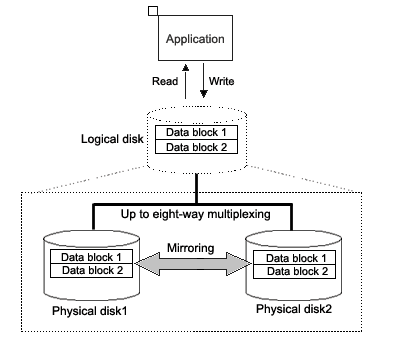
GDS supports mirroring of single disk units as well as mirroring between disk arrays. It can mirror disk units of various usage and configuration, including a system disk installed with an operating system, and a disk connected to multiple servers.
Examples of special mirroring implementation are explained below.
System disk mirroring can mirror system disks with Linux operating system installed.
If a system disk failure occurs, the entire system probably stops and even booting will become impossible, and operating system reinstallation will be required. As a result, service stop may remain for a long time.
System disk mirroring ensures continuous system operation even when a failure occurs in part of the disks.
Additionally, it enables system reboot in a situation where disk failure has occurred.
See
For the system conditions where the system disk can be mirrored, see "3.5 System Disk Mirroring Preconditions."
Figure 1.5 System Disk Mirroring
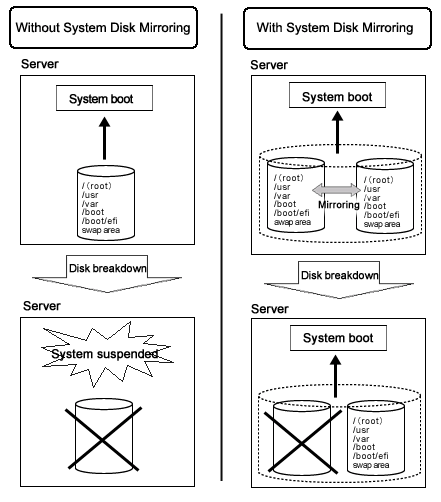
GDS can provide mirroring between high-performance and high-reliability disk arrays.
Mirroring two disk arrays connected with Fibre Channel can protect data from unexpected accidents and power shortage.
Moreover, disk units with redundant access paths can also be mirrored with specific software.
Figure 1.6 Mirroring between Disk Array Unit
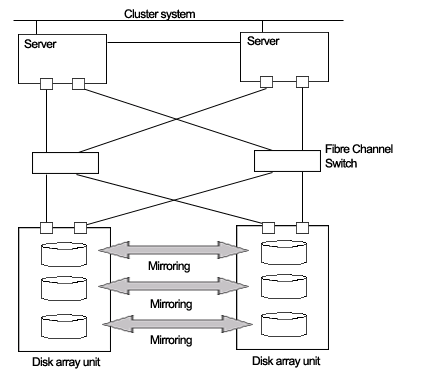
GDS can mirror shared disk units connected with a cluster system composed of multiple servers (also referred to as nodes).
Such mirroring is called shared disk mirroring in distinction from local disk mirroring that mirrors disks connected to a single node.
The GDS's shared disk mirroring function can be used with applications, such as the Global File Services (hereinafter GFS) Shared File System, that provide simultaneous access from multiple servers to shared disks, not to mention switch-over or standby type applications.
In the virtual environment (such as Xen, KVM, and VMware), shared disks can be mirrored using GDS which is operated on the guest OS.
Figure 1.7 Shared Disk Mirroring
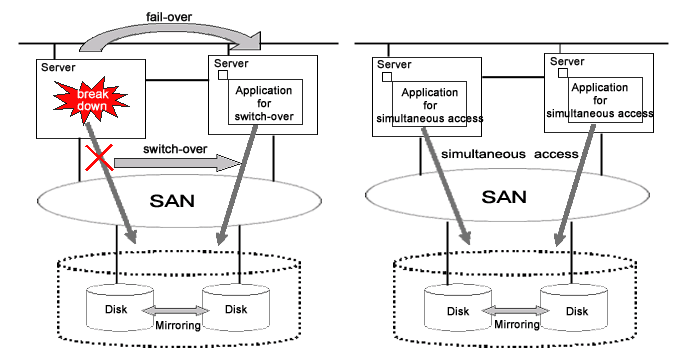
Mirroring among servers is a function that mirrors the local disks (such as an internal disk) of each server via the network in a cluster system configured with two servers.
Mirroring among servers can be used for taking over the data between nodes in a switch-over type cluster application that performs the standby operation. Compared to using the shared disk device, its features are as follows:
The cluster system can be configured at lower cost.
It does not require the setup and operation skills for the disk storage array.
Mirroring among servers is suitable for the following systems and operations:
Small scale systems
Operation with less data amount
Operation mainly consists of disk data reading
Figure 1.8 Mirroring among Servers
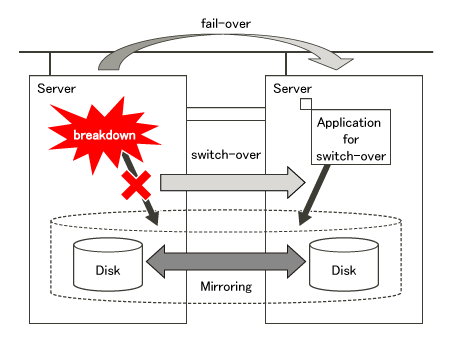
Note
The mirroring among servers is suitable for the operation if the amount of data and the amount of data update is small. If the amount of data and the amount of data update of the operation is large, and data accessibility performance or data availability is especially important, use the shared disk.
For details, see "3.9.5 Data Amount and Data Update Amount."
In the configuration of mirroring among servers, much time to switch the cluster application is required than in the configuration of shared disk. An additional few seconds are required for one netmirror volume to switch the cluster application. To switch the cluster application promptly, use the shared disk.
You cannot hot swap the disk that is the target of the mirroring among servers. When swapping the disk, stop the node once. The cluster application can be run on the other node during disk swapping. For details, see "7.3.3 Swapping Disks of Netmirror Group."
If the cluster interconnect fails or the node panics during the operation, I/O to the netmirror volume is suspended up to 2 to 3 minutes. For details, see "7.15.3 Operation when the LEFTCLUSTER Node Exists."
When the disk on another node cannot be accessed due to a network error, and when the resynchronization copying is performed after the network is restored, I/O to the volume is suspended for a few seconds for one volume. Lower number of volumes is recommended. The time to suspend I/O is about 4 to 5 seconds though it changes depending on the system.
In this version, do not connect the external disk unit with the system that uses the mirroring among servers.
In this version, the volume in the configuration of the mirroring among servers cannot be used in Symfoware Server(Native). When using Symfoware Server(Native), use the shared disk.
When using the mirroring among servers, see also "A.13 Notes on Mirroring among Servers [4.3A40 or later] [RHEL6]."